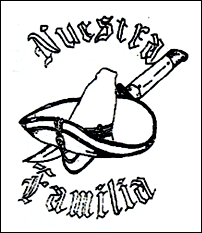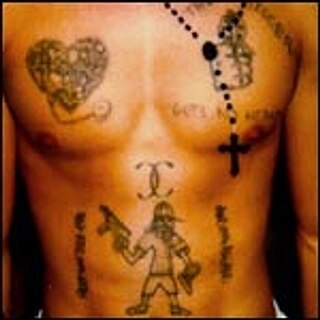Related Research Articles

Nuestra Familia is a criminal organization of Mexican American (Chicano) prison gangs with origins in Northern California. While members of the Norteños gang are considered to be foot soldiers of Nuestra Familia, being a member of Nuestra Familia itself does not signify association as a Norteño. Some law enforcement agents speculate that the Nuestra Familia gang, which operates in and out of prisons, influences much of the criminal activity of thousands of Norteño gang members in California. The gang's main sources of income are distributing cocaine, heroin, marijuana, and methamphetamine within prison systems as well as in the community and extorting drug distributors on the streets.
The Black Mafia, also known as the Philadelphia Black Mafia (PBM), Black Muslim Mafia and Muslim Mob, was a Philadelphia-based African-American organized crime syndicate. The organization began in the 1960s as a relatively small criminal collective in South Philadelphia, known for holding up neighborhood crap games and dealing in the illegal drug business, but at its height of operation in the early 1970s until about the early 1980s, it managed to consolidate power and control a large portion of criminal activity in various African-American neighborhoods throughout Philadelphia and the Delaware Valley, including South Jersey, Chester, and Wilmington. In addition to drug trafficking, burglary, and armed robbery, the Black Mafia was also engaged in traditional organized crime activities such as political corruption, extortion, racketeering, prostitution, loansharking, number running, and other illegal gambling rackets.
A prison gang is an inmate organization that operates within a prison system. It has a corporate entity and exists into perpetuity. Its membership is restrictive, mutually exclusive, and often requires a lifetime commitment. Prison officials and others in law enforcement use the euphemism "security threat group". The purpose of this name is to remove any recognition or publicity that the term "gang" would connote when referring to people who have an interest in undermining the system.

The Crips are an alliance of street gangs that is based in the coastal regions of Southern California. Founded in Los Angeles, California, in 1969, mainly by Raymond Washington and Stanley Williams, the Crips began as an alliance between two autonomous gangs, and developed into a loosely connected network of individual "sets", often engaged in open warfare with one another. Its members have traditionally worn blue clothing since around 1973.
In the late 19th and early 20th centuries, African American organized crime emerged following the first and second large-scale migration of African Americans from the Southern United States to major cities of the Northeast, Midwest, and later the West Coast. In many of these newly established communities and neighborhoods, criminal activities such as illegal gambling, and speakeasies were seen in the post-World War I and Prohibition eras. Although the majority of these businesses in African American neighborhoods were operated by African Americans, it is often unclear the extent to which these operations were run independently of the larger criminal organizations of the time.
Organised crime in Nigeria includes activities by fraudsters, bandits, drug traffickers and racketeers, which have spread across Western Africa. Nigerian criminal gangs rose to prominence in the 1980s, owing much to the globalisation of the world's economies and the high level of lawlessness and corruption in the country.

Approximately 1.4 million people in the United States were part of gangs as of 2011, and more than 33,000 gangs were active in the country. These include national street gangs, local street gangs, prison gangs, outlaw motorcycle clubs, and ethnic and organized crime gangs.
The United Blood Nation, also known as the East Coast Bloods, is a street and prison gang active primarily in the New York metropolitan area. It is the east coast faction of the California-based Bloods street gang. Their main source of income is the trafficking and sale of illegal drugs.

Sureños , also known as Southern United Raza, Sur 13 or Sureños X3, are groups of loosely affiliated gangs that pay tribute to the Mexican Mafia while in U.S. state and federal correctional facilities. Many Sureño gangs have rivalries with one another, and the only time this rivalry is set aside is when they enter the prison system. Thus, fighting is common among different Sureño gangs even though they share the same common identity. Sureños have emerged as a national gang in the United States.
The US state of Georgia has seen a rise in the number of gangs over recent years, in the main focused on the illegal drug trade.
Organized crime in the Netherlands, sometimes called penose is the organised criminal underbelly in Amsterdam and other major cities. Penose usually means the organizations formed by criminals of Dutch descent. It is a slang word coming from the old Amsterdam Bargoens language.
Although organized crime has always existed in Sweden, it has risen significantly in the 2000s. The number of organized criminal groups operating in the country continues to rise. In 2018, Sweden had the highest gun deaths in total across Europe, and deaths involving guns tripled in Sweden between 2012 and 2020.
A prison gang is an inmate organization that operates within a prison system, that has a corporate entity, exists into perpetuity, and whose membership is restrictive, mutually exclusive, and often requires a lifetime commitment. Political scientist David Skarbekargues the emergence of prison gangs are due to the dramatic increase in the prison population and inmate's demand for safety. Skarbek observes that in a small, homogeneous environment, people can use social norms to interpret what behavior is acceptable, but a large, heterogeneous setting undermines social norms and acceptable behavior is more difficult to determine. Prison gangs are geographically and racially divided, and about 70% of prison gang members are in California and Texas. Skarbek suggests prison gangs function similar to a community responsibility system. Interactions between strangers are facilitated because you do not have to know an individual's reputation, only a gang's reputation. Some prison gangs are transplanted from the street. In some circumstances, prison gangs "outgrow" the internal world of life inside the penitentiary, and go on to engage in criminal activities on the outside. Gang umbrella organizations like the Folk Nation and People Nation have originated in prisons.
Memphis, Tennessee serves as the Southern headquarters for Tennessee based street organizations in the Southern United States. In 2021, there were approximately 102 gangs with 13,400 gang members in the city.
The Rollin' 30s Harlem Crips are a faction, or "set", of the Crips alliance of street gangs. The gang was formed by Belizean American Crips who had moved from South Los Angeles to Belize and then to Harlem, New York.
The Florencia 13, also known as South Side Florencia 13,Florence Gang, F13 is an American criminal street gang based in Los Angeles, California, composed mainly of Mexican-Americans. The gang is named after the Florence area of Los Angeles County, controlled by the Mexican Mafia. They are involved in drug smuggling, murder, assault and robbery.

The Crenshaw Mafia are a "set" of the Bloods gang alliance. The gang are depicted in several movies including Boyz n the Hood and Straight Outta Compton.
References
- 1 2 3 Fred Brown (2007-07-15). "Gang fear lurks in shadows". The Denver Post. Retrieved 2010-07-28.
- 1 2 Osher, Christopher N. (2007-01-20). "Gang heirs drive reckless rise to power". The Denver Post. Retrieved 2010-07-28.
- ↑ Mark Wolf, Denver gangs: 'domestic terrorism' Archived 2011-09-29 at the Wayback Machine , Rocky Mountain Live blog, Rocky Mountain News website, January 18, 2007. Accessed December 6, 2010
- 1 2 3 David Holthouse (2001-11-08). "This Thug's Life - Page 1 - News - Denver". Westword. Retrieved 2010-07-28.
- ↑ Federal Bureau of Investigation (2009). "Gang Success Stories". Fbi.gov. Archived from the original on 2010-11-25. Retrieved 2010-11-19.
- ↑ Luke Turf (2007-02-22). "The Transformers - Page 1 - News - Denver". Westword. Retrieved 2010-07-28.
- ↑ "Aurora zeros in on gang crime count : Local News". The Rocky Mountain News. 2008-04-30. Retrieved 2010-07-28.